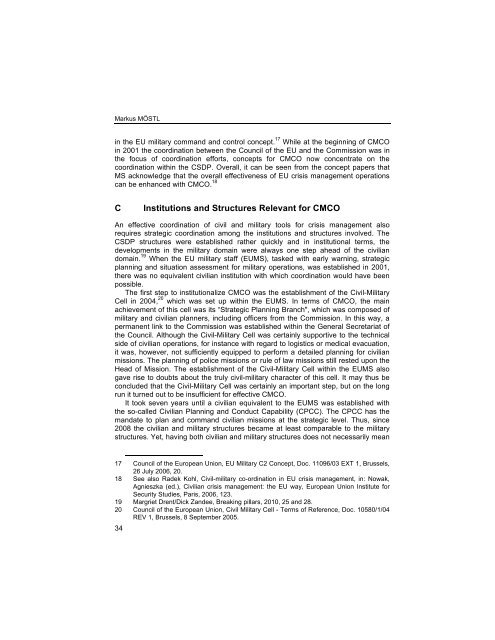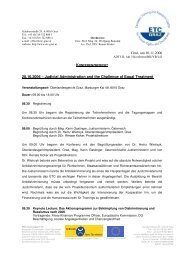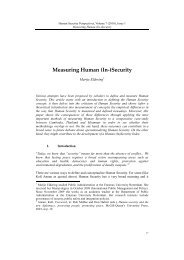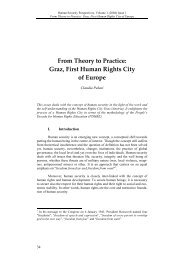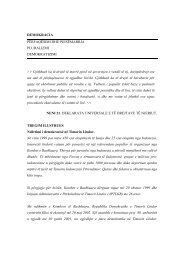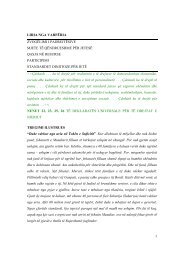Civil-military Coordination in the Common Security and ... - ETC Graz
Civil-military Coordination in the Common Security and ... - ETC Graz
Civil-military Coordination in the Common Security and ... - ETC Graz
You also want an ePaper? Increase the reach of your titles
YUMPU automatically turns print PDFs into web optimized ePapers that Google loves.
Markus MÖSTL<br />
<strong>in</strong> <strong>the</strong> EU <strong>military</strong> comm<strong>and</strong> <strong>and</strong> control concept. 17 While at <strong>the</strong> beg<strong>in</strong>n<strong>in</strong>g of CMCO<br />
<strong>in</strong> 2001 <strong>the</strong> coord<strong>in</strong>ation between <strong>the</strong> Council of <strong>the</strong> EU <strong>and</strong> <strong>the</strong> Commission was <strong>in</strong><br />
<strong>the</strong> focus of coord<strong>in</strong>ation efforts, concepts for CMCO now concentrate on <strong>the</strong><br />
coord<strong>in</strong>ation with<strong>in</strong> <strong>the</strong> CSDP. Overall, it can be seen from <strong>the</strong> concept papers that<br />
MS acknowledge that <strong>the</strong> overall effectiveness of EU crisis management operations<br />
can be enhanced with CMCO. 18<br />
C Institutions <strong>and</strong> Structures Relevant for CMCO<br />
An effective coord<strong>in</strong>ation of civil <strong>and</strong> <strong>military</strong> tools for crisis management also<br />
requires strategic coord<strong>in</strong>ation among <strong>the</strong> <strong>in</strong>stitutions <strong>and</strong> structures <strong>in</strong>volved. The<br />
CSDP structures were established ra<strong>the</strong>r quickly <strong>and</strong> <strong>in</strong> <strong>in</strong>stitutional terms, <strong>the</strong><br />
developments <strong>in</strong> <strong>the</strong> <strong>military</strong> doma<strong>in</strong> were always one step ahead of <strong>the</strong> civilian<br />
doma<strong>in</strong>. 19 When <strong>the</strong> EU <strong>military</strong> staff (EUMS), tasked with early warn<strong>in</strong>g, strategic<br />
plann<strong>in</strong>g <strong>and</strong> situation assessment for <strong>military</strong> operations, was established <strong>in</strong> 2001,<br />
<strong>the</strong>re was no equivalent civilian <strong>in</strong>stitution with which coord<strong>in</strong>ation would have been<br />
possible.<br />
The first step to <strong>in</strong>stitutionalize CMCO was <strong>the</strong> establishment of <strong>the</strong> <strong>Civil</strong>-Military<br />
Cell <strong>in</strong> 2004, 20 which was set up with<strong>in</strong> <strong>the</strong> EUMS. In terms of CMCO, <strong>the</strong> ma<strong>in</strong><br />
achievement of this cell was its “Strategic Plann<strong>in</strong>g Branch", which was composed of<br />
<strong>military</strong> <strong>and</strong> civilian planners, <strong>in</strong>clud<strong>in</strong>g officers from <strong>the</strong> Commission. In this way, a<br />
permanent l<strong>in</strong>k to <strong>the</strong> Commission was established with<strong>in</strong> <strong>the</strong> General Secretariat of<br />
<strong>the</strong> Council. Although <strong>the</strong> <strong>Civil</strong>-Military Cell was certa<strong>in</strong>ly supportive to <strong>the</strong> technical<br />
side of civilian operations, for <strong>in</strong>stance with regard to logistics or medical evacuation,<br />
it was, however, not sufficiently equipped to perform a detailed plann<strong>in</strong>g for civilian<br />
missions. The plann<strong>in</strong>g of police missions or rule of law missions still rested upon <strong>the</strong><br />
Head of Mission. The establishment of <strong>the</strong> <strong>Civil</strong>-Military Cell with<strong>in</strong> <strong>the</strong> EUMS also<br />
gave rise to doubts about <strong>the</strong> truly civil-<strong>military</strong> character of this cell. It may thus be<br />
concluded that <strong>the</strong> <strong>Civil</strong>-Military Cell was certa<strong>in</strong>ly an important step, but on <strong>the</strong> long<br />
run it turned out to be <strong>in</strong>sufficient for effective CMCO.<br />
It took seven years until a civilian equivalent to <strong>the</strong> EUMS was established with<br />
<strong>the</strong> so-called <strong>Civil</strong>ian Plann<strong>in</strong>g <strong>and</strong> Conduct Capability (CPCC). The CPCC has <strong>the</strong><br />
m<strong>and</strong>ate to plan <strong>and</strong> comm<strong>and</strong> civilian missions at <strong>the</strong> strategic level. Thus, s<strong>in</strong>ce<br />
2008 <strong>the</strong> civilian <strong>and</strong> <strong>military</strong> structures became at least comparable to <strong>the</strong> <strong>military</strong><br />
structures. Yet, hav<strong>in</strong>g both civilian <strong>and</strong> <strong>military</strong> structures does not necessarily mean<br />
17 Council of <strong>the</strong> European Union, EU Military C2 Concept, Doc. 11096/03 EXT 1, Brussels,<br />
26 July 2006, 20.<br />
18 See also Radek Kohl, <strong>Civil</strong>-<strong>military</strong> co-ord<strong>in</strong>ation <strong>in</strong> EU crisis management, <strong>in</strong>: Nowak,<br />
Agnieszka (ed.), <strong>Civil</strong>ian crisis management: <strong>the</strong> EU way, European Union Institute for<br />
<strong>Security</strong> Studies, Paris, 2006, 123.<br />
19 Margriet Drent/Dick Z<strong>and</strong>ee, Break<strong>in</strong>g pillars, 2010, 25 <strong>and</strong> 28.<br />
20 Council of <strong>the</strong> European Union, <strong>Civil</strong> Military Cell - Terms of Reference, Doc. 10580/1/04<br />
REV 1, Brussels, 8 September 2005.<br />
34


